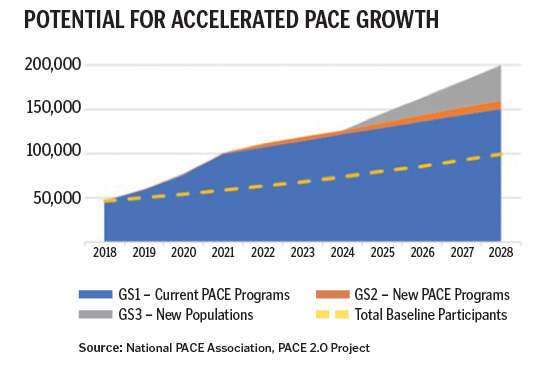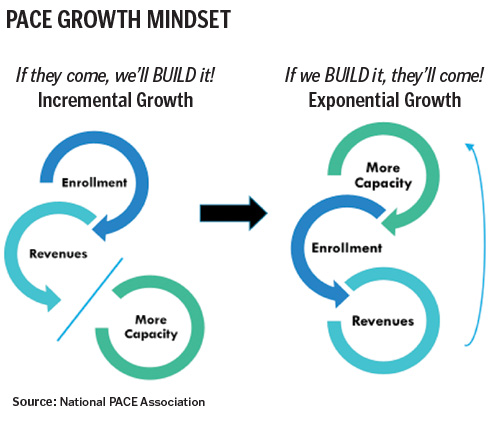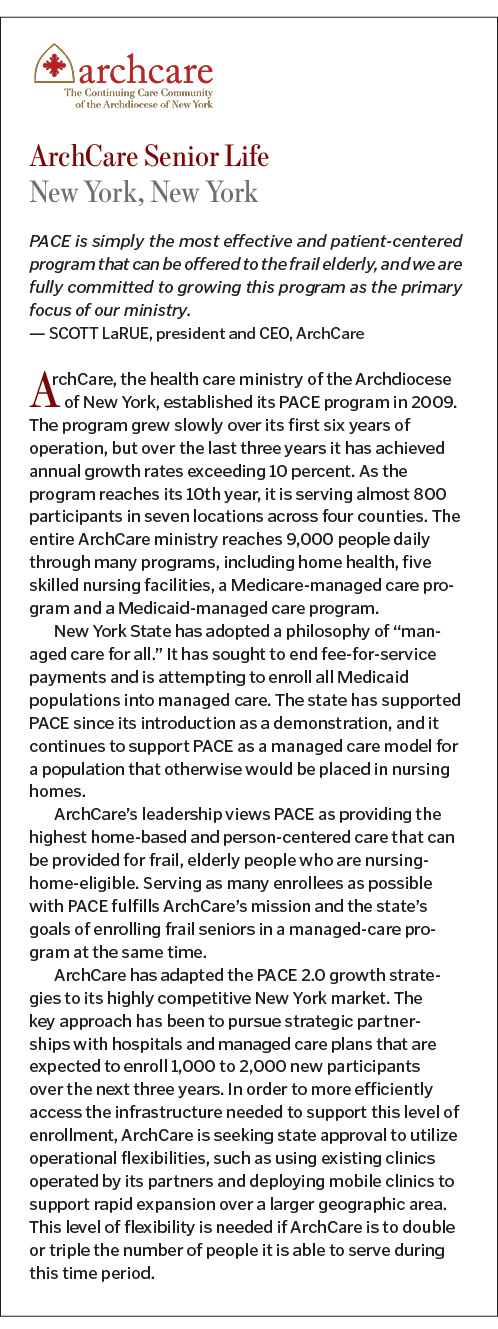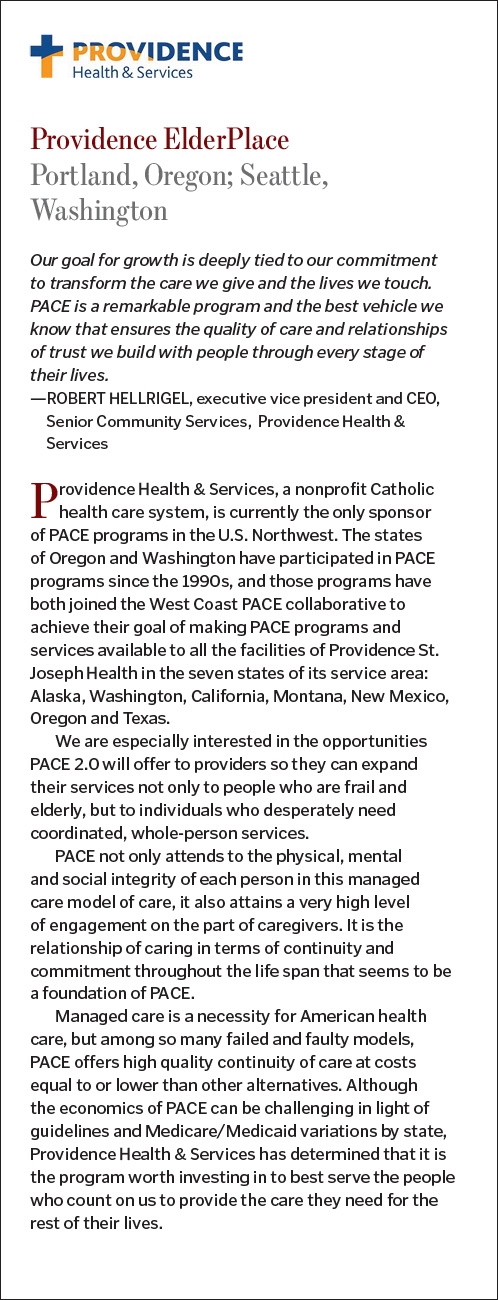BY: JADE GONG, MBA, RN, and PETER FITZGERALD, MSc.
Ask consumers, caregivers, payers or providers about their vision for the future of long-term services and support and the answers you hear are surprisingly consistent about how to aid those in need of daily self-care. They want supports to be person-centered, comprehensive, coordinated and community-based. Add the increased emphasis on value-based and capitated payment models that can address social determinants of health, and the solution looks a lot like the Program of All-Inclusive Care for the Elderly, commonly known as PACE.
Currently, PACE programs serve almost 50,000 seniors in 31 states, but that represents less than 10 percent of the eligible population in communities served by PACE. PACE programs bring care benefits, but establishing them is a complex undertaking. PACE organizations integrate all primary, acute and long-term care, so it takes time and they are capital-intensive to develop.
An initiative called PACE 2.0 has a goal of achieving significant growth in its programs nationwide over the next decade. In order to support this goal, PACE 2.0 is developing growth strategies for serving more of the nation's frail elderly people ages 55 and older, and looking ahead to expand services to high-need, high-cost populations not currently served by PACE. The new initiative is supported by two foundations that support healthy aging and age-friendly health systems, The John A. Hartford Foundation and West Health.
While the idea of operating a program that deals exclusively with a nursing-home eligible population may seem risky to some providers, many Catholic-sponsored providers have been attracted to PACE since it was first authorized as a demonstration in 1983. The PACE care model embodies the Catholic vision of health and health care, especially in the way it embraces the integrity of the person within a community. Today, many Catholic-sponsored organizations already have achieved tremendous success with PACE and now are moving to progress to PACE 2.0. See pages 56-57 for information on the PACE expansion work of ArchCare in New York, and Providence Health and Services in Oregon and Washington.
PACE IS A RADICAL REINVENTION OF LONG-TERM CARE DELIVERY
PACE is a comprehensive, community-based care model that serves primarily low-income, frail, older adults. The PACE care model integrates preventive, primary and acute care with support services, such as assistance with eating and dressing, across the full range of care settings, including at home. PACE provides many of these services directly, while contracting for other services, such as hospitalization or specialist care. Primary care, rehabilitative care, social activities and meals are provided at a PACE center. In a person's home, PACE organizations supply personal care assistance and skilled nursing. Transportation to a PACE Center, to medical appointments and to other community activities also is included in PACE services. Since PACE organizations are fully responsible for meeting all of an individual's care needs, they are incentivized and empowered to address each person's care holistically.
PACE is a covered Medicare benefit and offered as an optional Medicaid benefit in 31 states. Each local PACE organization receives a set monthly amount to provide all required care for low-income and frail elders. Each PACE organization has a defined service area; people who want to receive services from the program must reside within that area. Nationally, there are 124 PACE organizations in 235 communities across the U.S. Ninety-percent of individuals served by PACE are low-income adults, who are eligible for both Medicare and Medicaid.
Historically, the requirements for starting and expanding a PACE program have led to slow growth. Building a program involves the creation of a PACE center in a community and the ability to staff primary care, rehabilitative, in-home care, transportation and other services, and building the capacity to directly serve people through a provider-based model. The changing marketplace is generating new ways to address these challenges and the care approach continues to yield benefits.
PACE EFFECTIVENESS
The PACE care model results in reduced hospital admissions and emergency room visits, as evidenced in a number of state-specific and national studies.1 Other studies also show that the PACE model of care results in a substantial long-term survival advantage compared with aged and disabled waiver clients.2, 3
In the National Academy of Medicine report "Effective Care for High-Need Patients: Opportunities for Improving Outcomes, Value, and Health," PACE is identified as a model of care that fosters effectiveness in health and well-being, care utilization and costs.4 The PACE care model has met the criteria for inclusion in Substance Abuse and Mental Health Services Administration's National Registry of Evidence-Based Programs and Practices.5 This is a result of long and consistent evidence that affirms the PACE care model as supporting seniors' quality of care and quality of life in community-based settings.
The PACE care model achieves these results for less than or the same cost as other programs. On the Medicaid side, states pay PACE programs on average 16.5 percent less than the costs of caring for a comparable population through other Medicaid services, including nursing homes and home- and community-based waiver programs.6 In Medicare, payments to PACE organizations are equivalent to the costs for a comparable population to receive services through the fee-for-service program.7
WHY DO WE NEED PACE 2.0?
Despite this success, PACE programs only serve a small number of the 2 million people who are eligible for PACE. The goal of PACE 2.0 is to exponentially increase the number of individuals who can benefit from PACE to 200,000 by 2028.

Growth is projected from three sources:
- Growth Stream 1 (GS1 on the chart) — Current PACE Programs. The first source of growth is to scale up the services provided by current PACE organizations to people ages 55 or older who need a nursing-home level of care and are dual eligible for Medicaid and Medicare. The average PACE program enrolls approximately 350 people and has a service area penetration rate of 9 percent. However, some PACE organizations serve more than 1,000 participants and have market penetration of over 30 percent, which shows greater scale is possible.
- Growth Stream 2 (GS2 on the chart) — New PACE Programs. Another source of growth is to expand services to new communities through new PACE organizations. This growth will occur by increasing the number of communities offering PACE in states with existing programs and bringing PACE to the 19 states that do not offer PACE as a Medicaid program.
- Growth Stream 3 (GS3 on the chart) — New and Expanded Populations. Currently, PACE is limited to persons who are 55 years or older and at a nursing-home level of care. PACE pilots have been authorized by the PACE Innovation Act of 2015, which allows more flexible guidelines for age, level of care and payment models. PACE pilots may then allow PACE to be provided to persons who are under age 55, persons who are not yet nursing home eligible and to Medicare-only populations.
How Can An Existing Program Grow Now?
The PACE 2.0 Initiative began with looking at strategies that were already working to support rapid growth within existing programs. Looking at recent growth and enrollment data, PACE 2.0 identified six "Bright Spot" PACE organizations that were growing at twice the national average or serving more than 20 percent of the people in their communities needing long-term services and supports. Strategies and tactics that were common across these organizations were used to create a growth model that other PACE organizations could apply. The growth strategy was field tested at PACE of the Triad, a midsize PACE organization in Greensboro, North Carolina. During the field test, this PACE program increased its net monthly enrollment from 3 to 12 participants. The growth model is currently being tested by 10 additional programs in California, Washington and Oregon. The key learning, based on findings from the growing PACE organizations and field testing of the expansion model, was that organizations must establish the capacity for growth without waiting for incremental increases in enrollment to justify adding resources to the program. This involves switching from an "if they come, we will build it" to an "if we build it, they will come" mindset (see figure below).

By projecting the population in need and then putting sufficient resources in place to deliver services, PACE organizations will have sufficient staff, space and organizational systems to support exponential enrollment growth. This synchronizes resources to new enrollment and maintains the quality of services and supports it offers to its current participants. Organizations looking to expand should invest in outreach and enrollment systems that will support enrollment as programs build capacity. Overall, the PACE organization needs to embrace rapid growth as a priority so that more people can benefit from its services.
Through a West Coast learning collaborative, 10 PACE organizations, including eight from California and one each from Oregon and Washington state, are applying the growth strategy. These organizations are participating in a yearlong learning collaborative based on the Institute for Healthcare Improvement's Breakthrough Series method, which includes tactics to support improvement. Collectively, these organizations aim to add almost 2,000 PACE participants by November 2019, the end of the collaborative's year.
OPPORTUNITIES FOR INVOLVEMENT
Catholic-sponsored health care organizations can get involved by joining one of the regional PACE 2.0 learning collaboratives being developed. These organizations will apply the field-tested growth strategy model as well as the IHI implementation tactics to help PACE organizations across the country achieve the growth they envision. The PACE 2.0 web page on the National PACE Association's website has extensive materials on how to accelerate PACE growth. (See resource weblinks at end of article.)
For organizations looking to develop a new PACE organization, the PACE 2.0 initiative is studying fast-start PACE organizations to develop a start-up strategy for expediting enrollment. The National PACE Association will offer this strategy for use by new PACE organizations beginning in mid-2019. Catholic health organizations can start now by reaching out to their state Medicaid agencies and discussing opportunities for PACE growth.
Looking further ahead, the potential for PACE pilots that expand the program to new high-need, high-cost populations would provide even greater opportunities to expand services to people who need them. These new PACE populations could include younger people with disabilities, people at-risk of needing a nursing home level of care and Medicare-only individuals who want more affordable payment options.
WHAT'S NEXT?
The first half of 2019 could see implementation of some significant federal policy actions that have the potential to add momentum to the PACE 2.0 project's aspirations. A final PACE regulation offering more flexibility for incorporating community-based resources — including primary care and adult day care — into the PACE model will help currently operating and new programs grow more quickly and efficiently.
It's also expected that the Centers for Medicare and Medicaid Services will move forward with PACE pilots to allow the program to serve new populations. These pilots could offer the opportunity to serve people at different ages and levels of care, while also providing more affordable options for Medicare-only individuals to enroll in PACE.
JADE GONG is principal of Jade Gong and Associates, Arlington, Virginia, and is a strategic adviser to start up and operating PACE programs nationwide. PETER FITZGERALD is the executive vice president for policy and strategy at the National PACE Association and leads the PACE 2.0 national initiative.
RESOURCES RELATED TO STARTING A PACE PROGRAM:https://www.npaonline.org/start-pace-program/understanding-pace-model-care
RESOURCES ON GROWING AN OPERATING PACE ORGANIZATION AND ON SERVING NEW POPULATIONS:
https://www.npaonline.org/member-resources/strategic-initiatives/pace2-0
NOTES
- Division of Health Care Finance and Policy, Executive Office of Elder Affairs; PACE Evaluation Summary (2005). Accessed on May 25, 2011, http://www.mass.gov/Eeohhs2/docs/dhcfp/r/pubs/05/pace_eval.pdf. Pamela Nadash, "Two Models of Managed Long-Term Care: Comparing PACE with a Medicaid-Only Plan, The Gerontologist 44, no. 5, (October 2004), 644-54. Robert L. Kane et al., "Variations on a Theme Called PACE," Journal of Gerontology, Series A 61, no. 7 (July 1, 2006): 689-693, https://doi.org/10.1093/gerona/61.7.689.
Micah Segelman et al. "Hospitalizations in the Program of All-Inclusive Care for the Elderly," Journal of the American Geriatrics Society 62, no. 2 (2014): 320-24. - Darryl Wieland, Rebecca Boland, Judith Baskins, and Bruce Kinosian, "Five-Year Survival in a Program of All-Inclusive Care for Elderly Compared with Alternative Institutional and Home- and Community-Based Care," The Journals of Gerontology Series A: Biological Sciences and Medical Sciences 65, no. 7 (2010): 721-26. doi:10.1093/gerona/glq040.
- Arkadipta Ghosh, Robert Schmitz and Randall Brown, "The Effect of PACE on Costs, Nursing Home Admissions and Mortality: 2006 – 2011," Mathematica Policy Research evaluation prepared for U.S. Department of Health and Human Services, Office of the Assistant Secretary for Planning and Evaluation and Office of Disability, Aging and Long-Term Care Policy (2015). https://aspe.hhs.gov/report/effect-pace-costs-nursing-home-admissions-and-mortality-2006-2011.
- National Academy of Medicine, "Effective Care for High-Need Patients: Opportunities for Improving Outcomes, Value and Health," 2017. https://nam.edu/HighNeeds/.
- Substance Abuse and Mental Health Services Administration, National Registry of Evidence-Based Programs and Practices, https://nrepp.samhsa.gov/Legacy/ViewIntervention.aspx?id=316.
- National PACE Association, "Upper Payment Limits and Medicaid Capitation Rates for Programs of All-Inclusive Care for the Elderly," March 2017.
- Ghosh, Schmitz and Brown, "The Effect of PACE."


